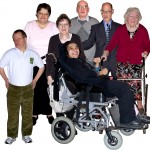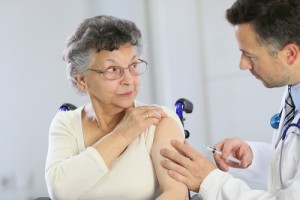
People with learning disabilities often have additional health conditions or mental health problems and so may have increased need for medical interventions. However, people with learning disabilities have more unmet health needs and struggle to access treatment. It is suggested this is due to health practitioners failing to make reasonable adjustments and poor communication between people with learning disabilities, their carers and health professionals (Dobson & Gullard., 2008).
Health care for all (Michael, 2008) recommended that there should be mandatory training for doctors on working with people with learning disabilities. The General Medical Council has also recognised the need to improve doctors’ understanding of the needs of people with learning disabilities and the GMC said they would develop materials to raise the awareness of the needs of people with learning disabilities (Hitchen, 2010). For an example – see GMC learning disabilities website.
To help improve the skills of medical students standardised patients are used. Standardised patients are people role-playing patients.

People with learning disabilities often have additional health conditions and so may have increased need for medical interventionsbut can struggle to access treatment
In the US, a variety of doctor training programmes have used standardised patients to provide experience of working with people with learning disabilities (Barzansky, 2004). In the UK St George’s Hospital Medical School has involved people with learning disabilities in medical training. Students have said this helps the understanding of non-verbal cues, developing a more thorough approach and reducing diagnostic overshadowing (Thacker, et al., 2007).
Diagnostic overshadowing is when all a person’s health problems are assumed to be caused by one diagnosis, in this case learning disability, at the exclusion of other possibilities.
This paper reports a pilot conducted by University College London (jointly with a number of other NHS trusts) using people with learning disabilities as standardised patients during doctor training.
Method
The team advertised for and recruited people with learning disabilities from the local community to be actors. They had 21 people respond to the advert for the project. The team selected 9 people to act as patients and gave them 8 weeks of training. The team used a support worker from the local Advocacy Project to facilitate the training sessions. Each person was trained in giving structured feedback and in four common clinical scenarios,
- Simulating a person with depression
- Requesting an explanation of a medical procedure or medication
- Receiving bad news
- Taking history from a person with epilepsy.
The team offered fourth year medical students at UCL, the option to take part in the pilot. Forty-seven medical students were awarded a place on a first come first served basis.
The training comprised of a morning session on communication with a speech and language therapist. Following this the students were divided into four groups and rotated around the four role play stations. The students received ongoing feedback from the actors and then an overall debrief was given at the end by the pilot team.

Actors with learning disabilities were trained in 4 scenarios and feedback and were used as part of a training course with medical students.
The team measured students’ self-appraisals using a questionnaire developed by Robey, Gwiazda and Morse (2001) before and after the training. The questionnaire comprises of the presentation of a scenario followed by 12 items in three sub scales; perceived skill, comfort and type of approach. Each student was presented with the same three scenarios.
- an out-patient with a common complaint, but with no physical or intellectual disability
- an out-patient with the same complaint with a mild learning disability
- an out-patient with the same complaint with a severe learning disability.
The team had two hypotheses:
- The above course would improve student’s perceived skill, comfort and type of approach in both scenarios describing people with learning disabilities.
- There would be greater change in the response to the scenario with the person with severe learning disabilities.
Results
- The students reported significant improvements on all scales across each of the three conditions.
- There was significantly greater effect of training on perceived ability in working with people with a severe learning disability when compared to working with someone with a mild learning disability.
Conclusions
This pilot suggests that training on communication with people with learning disabilities and using standardised patients in this process improves student’s self-evaluation of perceived skills, comfort and type of approach.
There was positive feedback on the process from the students and actors.
It seems that the inclusion of people with learning disabilities in doctors training has positive effects and should become the norm and not the exception.
Strengths and limitations
The team seemed to work hard to involve people with learning disabilities at every stage of the design process and additional reasonable adjustments were made for an actor who found given feedback challenging which allowed her to continue to play an active role in the process.
As stated by the team there may be volunteer bias due to the nature of recruitment, which may lead to the students already being predisposed to viewing the process as positive and so it would be interesting to repeat the measures when the training package become compulsory.
The authors chose to measure the effectiveness of the entire training package and did not attempt to measure the impact of the standardised patients alone. It would have been nice to see the measure used in-between the morning session on communication and the session with the actors. This would allow conclusions to be drawn about the impact of each section of the training independently.
The authors did not report when the questionnaires were given to the students, it is presumed that they were done immediately prior to and following the training course. This is when any training will have the greatest impact. Longer term follow up would have provided information regarding the continued impact of the training.
Additionally, the authors did not measure changes in communication skills; they used a self-report measure of perceived changes. It would be useful to know if this training course changes student behaviour as well as their perceived self-efficacy.
Summary
It is critical that the experience of seeing a doctor is as positive as possible, with all the participants feeling confident and comfortable. This is especially true for people with learning disabilities, due to the increased likelihood of needing more medical interventions. Anything that improves the communication skills of doctors is a positive.
This pilot provides a good description of one approach that improves students perceived skill, comfort and approach. The training structure and use of standardised patients appears to be a good model for the people involved in training doctors to consider using more widely. It would seem that if this was a regular part of the training programmes, that each training programme could work with the local advocacy groups to sustain a “pool” of trained actors and so there would be a reduced need for training of the standardised patients.
This would increase sustainability of such a project.The authors suggest that there are also other methods of involving people with learning disabilities in medical training such as the use of DVDs or web based videos, however, this does not allow for the interaction with and feedback from people with learning disabilities.
Overall this was a well thought out, practical study which would allow others involved in training doctors to consider how to involve people with learning disabilities in training.

Results suggest using actors with learning disabilities in medical student training has a positive effect on communication and diagnostic skills suggesting pilot could be expanded
Links
Thomas, B Courtenay K, Hassiotis A, Strydom A Rantell K, Standardised patients with intellectual disabilities in training tomorrow’s doctors, in Psychiatric Bulletin (2014), 38, 132-136
References
Dobson R, Gulland A. UK inquiry finds people with intellectual disability receive less effective treatment. BMJ 2008; 337: a1087.
Michael J. Healthcare for All: Report of the Independent Inquiry into Access to Healthcare for People with Learning Disabilities. Department of Health, 2008.
Hitchen L. GMC prioritises care of people with intellectual disabilities. BMJ 2010; 341: c4491.
Barzansky B, Etzel SI. Educational programs in US medical schools. JAMA 2004; 292: 1025-31. 333-40.
Thacker A, Crabb N, Perez W, Raji O, Hollins S. How (and why) to employ simulated patients with intellectual disabilities. Clin Teacher 2007; 4: 15-20.
Robey KL, Gwiazda J, Morse J. Nursing students’ self-attributions of skill, comfort, and approach when imaging themselves caring for persons with physical impairments due to developmental disability. J Dev Physical Disab 2001; 13: 361-71.
Access Simulations (http://www.access-simulations.co.uk/)
Advocacy Project (www.advocacyproject.org.uk)

RT @LearningDisElf: Using actors with learning disabilities during training to improve doctors’ communication and diagnostic skills http://…
Including people with learning disabilities in doctors training http://t.co/VMDHSWzAtt < Debut blog from clinical psychologist Tom Crossland
A pilot suggests that the inclusion of actors with learning disabilities in doctors training has positive effects http://t.co/VMDHSWzAtt
Article @LearningDisElf suggests using actors with learning disabilities in doctors training has positive effects http://t.co/SGhyRQxfnA
Using actors with learning disabilities during training to improve doctors’… @LearningDisElf http://t.co/7KfTGn4ANT http://t.co/CiJHvFtn7X
Using actors with learning disabilities during training to improve doctors’ communication and… http://t.co/VMw6sEym4b
Don’t miss: Using actors with LD during training to improve doctors’ communication and diagnostic skills http://t.co/VMDHSWzAtt #EBP
Health care for all (Michael, 2008) recommended that there should be mandatory training for doctors on working… http://t.co/z9y4VopWKh
#B1Less News actors w learning disabilities training to improve dr’ communication DX skills http://t.co/0r1Jx6n33x #CDCwhistleblower